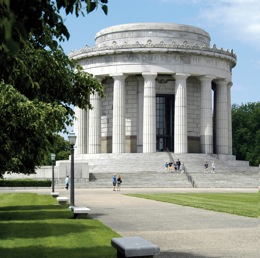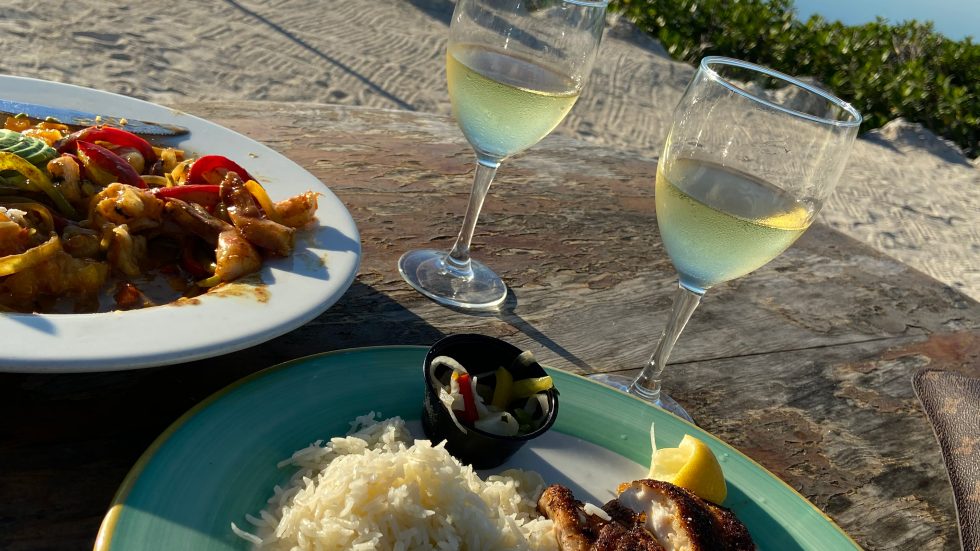On a journey that lasted 18 cold days and nights, George Rogers Clark led a force of 175 American and French militia from Kaskaskia, Ill., to Vincennes, Ind., with the goal of capturing Fort Sackville. But this was no road trip. To reach Vincennes, the oldest city in Indiana, Clark and his men marched through 120 miles of land flooded by winter snow melts and rains and traveled in — not along — the Wabash River where Fort Sackville sat.
How arduous was that?
To show me, Pamela Nolan, a park ranger and interpretative guide for the George Rogers Clark Memorial, tells me to put my hand in a metal can filled with ice cold water. Since Nolan, garbed in the fashion of women’s wear during Revolutionary War times, is holding a long rifle like the ones carried by Clark’s militiamen, I obey her.
The water is achingly cold. But that’s just the beginning.
“Hold this over your head,” Nolan says, thrusting the rifle in my hands. “The men didn’t want their rifles to get wet, so they had to move through the river holding them above their heads. The water sometimes reached their necks. Imagine doing this for three straight days. And then imagine sleeping on the cold, hard ground without having eaten anything for those three days.”
It’s hard to imagine, since standing in this position for three short minutes seems difficult enough. The defeat of the British at Fort Sackville forced them to surrender a huge tract of land west of the Appalachian Mountains — land that now includes Ohio, Indiana, Illinois, Michigan, Wisconsin and the eastern portion of Minnesota. It was one of the great victories of the Revolutionary War and one of the reasons we’re all not drinking tea and saying “jolly good.”
The massive granite memorial with its 16 Doric columns on the banks of the Wabash commemorates a hero that many of us confuse with his younger brother, William, who, with Meriwether Lewis crossed the continent of the United States in the early 1800s. William was just a boy when his eldest brother, 18 years his senior, reached heroic stature.
Vincennes, founded in 1732, was originally a French fur trading post. A charming town filled with immaculately restored late 18th century homes and storefronts, Vincennes is also home to the Old Cathedral, build in 1826. The cathedral stands on the site of three previous churches, including a basic log structure that was built in 1732.
Like the nearby memorial, the cathedral is substantial, made of red brick. A courtyard, laid out in the symmetrical style typical of French gardens, connects it to Old Cathedral Library and Museum. Here again is another first, the oldest library in Indiana, containing 10,000 rare volumes that date back to 1319.

Both the cathedral and the memorial are located in downtown Vincennes. The town is good for walking. Take a stroll down Fifth and Sixth streets past historical homes with cupolas, verandahs, bay windows and turrets, representative of many styles including Queen Anne, Victorian, Romanesque and Italianate to name a few.
Downtown Vincennes is full of stores and restaurants, typical of what used to be common for a small town’s main street — something that is seen less and less as outlying malls destroy the charm of small towns. Stop at Pea-Fections, famed for its desserts, which creates its own recipes and offers an extensive menu featuring salads, croissants and soups.
Near the downtown is stately Grouseland, the home of William Henry Harrison, who lived there from 1803 to 1812. Harrison, maybe best remembered for the slogan “Tippecanoe and Tyler Too” when he ran and won the presidency in 1841, was a governor of the Indiana Territories when he had the home built. The mansion, opulent and filled with furniture from that time period, was designed to resemble the Harrison ancestral home in Virginia. When Harrison moved out, he gave the home to his son, and it remained in the family until 1850.
Like the Clarks, this was a family with a pedigree. William Harrison’s father was a signer of the Declaration of Independence, and his grandson was Benjamin Harrison, the 23rd president of the United States.
In Harrison’s time, the house stood on 300 acres that stretched down to the Wabash River. The land was used for farming and raising livestock. Now, also located on the site is the Vincennes State Historic Sites, which includes the Indiana Territory Capitol, Jefferson Academy, Elihu Stout Print Shop and the Maurice Thompson Birthplace.
For the first 13 years, at the beginning of the 1800s, Vincennes was the capital of the Indiana Territory. The Indiana Territory Capitol, a two story framed structure put together with wooden pegs, was one of the buildings used by the Territorial Legislature and is considered the oldest major government building in the Midwest. Restored in colors that were appropriate to the times and furnished in a style typical of a territorial legislature, the building is another peak back into time.
The Jefferson Academy was the first college in Indiana and is the direct predecessor of Vincennes College, located across the street. Starting in 1904, Elihu Stout published Indiana’s first newspaper, the Indiana Gazette, in Vincennes. The authentic Ramage press is of the era when Stout was turning out the four-page paper. National news might be several weeks old, given the time it took to travel from the east to Indiana and then printed up. International news might be months old.
Maurice Thompson, author of Alice of Old Vincennes, was born in the small frame house that is also part of the Vincennes State Historic Sites. Peeking into each of these gives a visitor a sampling of what life two centuries ago on the frontier was like.
For more information or to plan your visit, call the Vincennes/Knox County Convention & Visitors Bureau at 800-886-6443 or visit www.vincennesonline.org.


